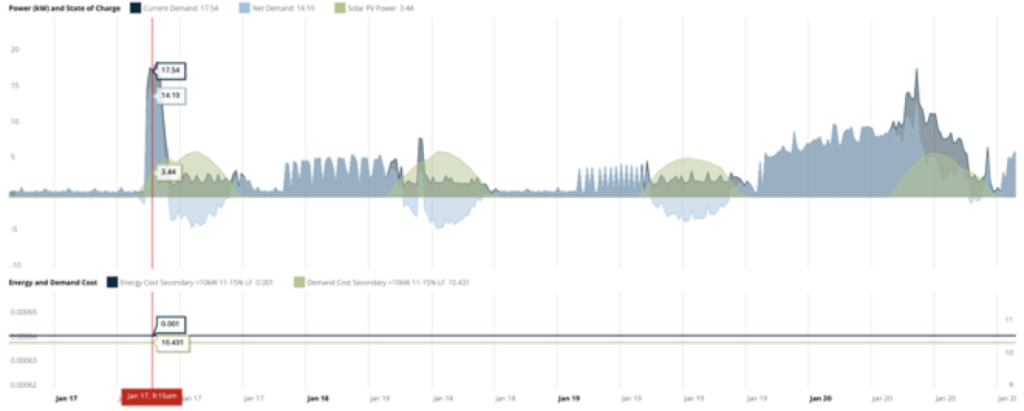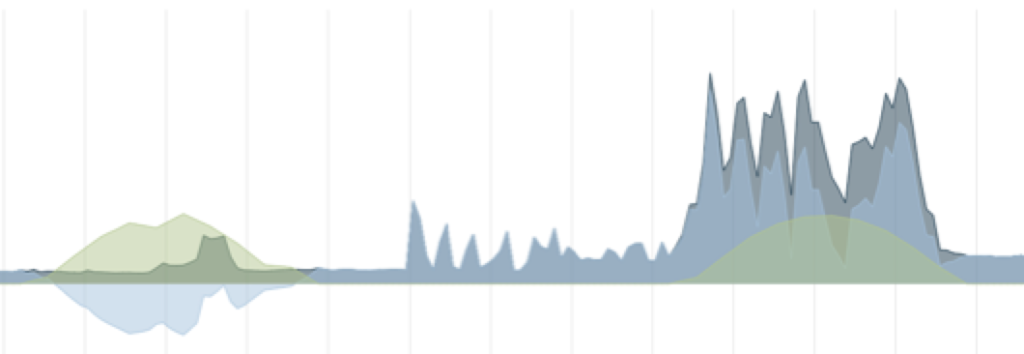Solar in Commercial facilities is a lot different than Residential solar. If you own or manage large facilities in Texas, this article is for you.
Does Commercial Solar Make Financial Sense?
As a large commercial facility owner and/or manager, most of what you do is financially driven.
So does commercial solar make financial sense in Texas?
Most of the time, yes.
Most businesses will want to see a financial return at least as good as their borrowing rate or what they can get from investing money elsewhere. This is called the “hurdle rate” and is usually somewhere between 5-10%.
When properly designed and procured, most commercial solar systems will be able to meet or exceed this return. We routinely see Internal Rate of Return (IRR) of 5-15% or more after applicable tax incentives and utility rebates.
This assumes $/kWh commodity rates are $0.06-0.10/kWh.
Note that some utilities have rate tariffs are highly weighted to DEMAND and have very low CONSUMPTION charges of $0.01-.03/kWh. It is hard to make a financial case for solar in these markets.
What Are the Components of a Commercial Solar System?
A solar system primarily consists of solar panels, racking to mount the panels, and inverters to take the DC power and convert it to AC. There’s a lot of other common electrical items like conduits, breakers, junction boxes, etc., but that’s the unique solar components.

Commercial solar systems are commonly roof mounted, ground mounted, or carport mounted. We’re usually planning to put a system in Behind the Meter, which means we want to tie in the power to the building’s electrical system after the utility electric meter (more on this later). As such, proximity to the power is key.
Below is a graphical example of how a Behind The Meter (BTM) works:

Roof mounted systems work well if your existing roof is in good condition, oriented the right direction (primarily a concern for sloped roofs), and can support the load (mainly a concern for ballast mounted flat roof systems).
The nice thing is roof mounted solar doesn’t take any additional space and is still low cost. If you have a flat roof the engineer will need to confirm it has enough load bearing capacity to support the weight of a ballasted (weighted) system.
Ground mounted system can be lower cost on large installs if land is available near the facility. The cost of running wire a long distance can get expensive, so proximity is key.
Carport solar provides the best of both of both worlds from ground mount and roof mounted systems. They are the most expensive as you need to build the carport structure, but the cost may be worth it since you get a lot of covered parking. This can be a big benefit for building occupants.

How Does Solar Power Reduce Your Electricity Cost?
When you install solar, you are incurring a cost for a project either up front (cash) or more likely as a recurring cost in the form of a payment.
In exchange, the system will produce a certain amount of power each year. This power is either worth what you don’t have to pay to the utility company, what they will buy the power from you for, or a combination of both.
KEY TAKEAWAY
Understanding how your facility uses electricity vs. how the solar system will produce power is key to accurately calculating your savings.
Commercial electric rates are usually a lot more complicated than residential rates. Rather than simply being a $/kWh, there is a usually a charge based on demand (KW). This is based on how quickly you consume power.
Think of it like miles traveled vs. miles per hour. You might go 60 miles in one hour, but your speed could range from 30mph to 100mph throughout that time. The utility doesn’t just charge you for traveling 60 miles, but also on your highest rate of speed (100mph).
Here’s a graph of a facility that has electric heat. You can see that on a cold Winter days the electricity use spikes for about 1 ½ hours each morning. The utility is charging this customer on the highest 15-minutes of usage each month and it is a major part of their bill.

On this chart you can see when solar will produce power (in Green) vs when the building uses power. Since the spike was in the early Winter morning before solar would start producing much, this part of the customer’s bill would not be reduced much by solar.
Because of this, we need to calculate the savings for solar mostly based on the CONSUMPTION (kWh) part of the bill and not the DEMAND (KW) part of the bill. In this case that was about $0.11/kWh and about $11/KW. If we simply used the BLENDED RATE of ~$0.20/kWh we’d be overstating savings significantly.
Net Metering
In addition to understanding Demand vs. Consumption rates, we must also understand Net Metering.
If you look at the usage (blue) and solar production output (green) below you can see that the first day was likely a weekend when the building was mostly turned off. Because the solar was producing more than the building needed, it was pushing power back to the grid. This is shown in the light blue color below the line.

If a utility provides Net Metering, this power will be credited against usage at another time.
However, when there’s no Net Metering the utility will usually pay you LESS for that exported power than what you pay to buy power.
As such, it is important that a system is properly sized for you building and a full analysis of policy and rate is completed to accurately calculate savings. You can read more about this in our article on Properly Sizing Solar Systems.
What Does it Cost?
The Lawrence Berkley National Laboratory tracks solar costs. In 2021 the National Average for Small Commercial systems was $3/W and Large Commercial was $2/W. These costs are before incentives.
We generally see commercial solar rates for projects in the 50-500KW-dc range in the $2.25-2.50/W range in Texas. This means a 50KW system at $2.50/W would cost $125k while a 500KW system at $2.25/W would be $1.125M.
The good news is, there’s a lot of tax incentives that reduce this number.
In August 2022, the Inflation Reduction Act was passed. This increased Federal tax incentives for renewable energy systems and extended their availability till 2032.
If you’re looking at a system under 1MW, you can get 30% of the cost back as a Tax Credit. In addition, you can get Bonus Credits of 10% for using Domestic Content, being in a Low Income Area, or being in an Energy Community. This means you could be at a total of 60% of cost back in CREDITS.
In addition, you can depreciate the system using a MACRS schedule. This provides a tax DEDUCTION that significantly reduces the cost even further.
Lastly, you might be served by a Utility (like Oncor, CenterPoint, TNMP, etc.) that will provide additional incentives.
All in, it’s not uncommon to see tax and utility incentives reduce the cost of a solar system by 50-70% or more. These cost savings, combined with your rate, is how you get to an IRR of 5-15% or more.
You can read more about the Inflation Reduction Act (IRA) in our resource article here.
Should You Use a PPA?
PPAs, short of Power Purchase Agreements, are a way to buy a solar system without using cash or debt. Basically you’re leasing the system. A 3rd party legally owns the system and you pay for it by paying a $/kWh for every kWh the system produces.
This can work well, but you still need to understand everything we’ve discussed so far. The PPA is usually a more expensive way to buy the system vs. buying it with a loan yourself, but it has some built in risk reduction and financial benefits.
However, PPAs can be tricky. We often see companies market a PPA rate that may be lower than your BLENDED utility rate, but not account for the difference in DEMAND and CONSUMPTION we talked about earlier.
You will also pay the same PPA rate for all the power the system produces, even if some of it is going back to the utility for a lower buyback rate than your PPA rate. For this reason, understanding your rate and system sizing is critical to getting the right system from a PPA.
KEY TAKEAWAY
If both the above points are not considered you could end up paying significantly MORE for your electricity by installing a solar system.
We highly recommend you engage a professional consultant like our company before entering into a PPA agreement.
Financial Summary
Below is a financial summary from a system we completed recently modeled. This was the system that had the high Winter morning peak and is about a 10KW system estimated at $3/W gross cost. It is in the Oncor utility and pays a commodity rate of about $0.10/kWh. The Blended Rate for this site was closer to $0.20/kWh due to the high demand charges.

Here’s a breakdown of the incentives that will apply to the project:

You can see that even at a conservative cost estimate of $3/W, this will provide the business owner a handsome return on their investment of over 11% per year. Since this was a small owner occupied building, it made a lot of sense to move forward and the financials may improve once costs are finalized.
Sustainability Benefits
We’ve been talking about the technical and financial benefits of solar, but there’s also a renewable benefit. If your organization has an ESG or CSR program that includes carbon reduction, on-site solar can go a long way towards reaching your goals.
Note that in order to include the value of carbon reduction you need to retain the Renewable Energy Credits (RECs) for yourself. Usually a PPA structure requires you assign the credits to the PPA system owner for sale on the open market. Some utility rebate programs also require assignment of the RECs.
If you assign the REC, someone else bought the value of that carbon reduction and you wouldn’t be able to use it to your organization’s goals.
Conclusion
We admittedly just scratched the surface of all that goes in to a good solar system design, procurement, and deployment.
When done well, it can be a very effective away to reduce your organization’s overhead cost and improve Net Profit.
Done poorly, it can cost you a lot of money for the next 20+ years.
We recommend that you engage a 3rd party owner’s rep like Holistic Utility Solutions to help you develop a solar system of any appreciable size. While we offer turnkey solar design and installation services throughout Texas and are very careful to follow all the proper calculations as described here, we also work with owners who want an unbiased consultant to help evaluate proposals from other firms.
In either situation, we’d welcome the opportunity to help you evaluate and implement your commercial solar system.
Send me an email at ira@holisus.com and I’d be happy to talk more.
Be Blessed,
Ira

